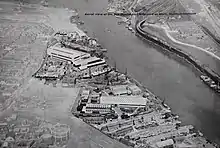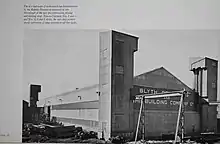Blyth Shipbuilding Company
The Blyth Shipbuilding & Dry Docks Company Ltd. was a British shipyard located in Blyth, Northumberland, England.
| Type | Limited company |
|---|---|
| Industry | Shipbuilding |
| Founded | 2 March 1883 |
| Defunct | 1967 |
| Fate | Dissolved |
| Headquarters | , |

Company history
Early history
Shipbuilding began on the site on the south bank of the River Blyth in 1811. In the 1840s the yard was purchased by Beaumont and Drummond. In 1863 the yard was taken over by Hodgson and Soulsby who repaired and built small wooden sailing ships. In 1880 the first two iron ships were built at Blyth for the Russian Government.[1]

Foundation
On 2 March 1883 the Blyth Shipbuilding & Dry Docks Company Ltd. was registered as a limited liability company. It built cargo liners, tramp steamers and colliers. The fifth ship built at the yard was for the shipping company Stephens and Mawson of Newcastle. Daniel Stephens eventually became a Director, and then the Chairman of the company.[1]
World War I
In 1914 a cargo ship under construction was purchased by the Admiralty and converted into the Navy's first seaplane carrier Ark Royal. During the war the company completed nine tramps and colliers,[1] along with ten X-lighter landing craft[2] and six sloops for the Royal Navy; these were the Arabis-class minesweeper Verbena, the Aubrietia-class convoy escorts Aubrietia and Gaillardia, the Anchusa-class convoy escort Ivy and the 24-class fleet minesweepers Merry Hampton and Ormonde.[3]
Post-war slump and closure
Post-war the company returned to the civilian market building steamers and colliers. However, after Daniel Stephens death on 19 March 1925, and the collapse of the freight market, the yard was closed. In November 1926 Robert Stanley Dalgleish, a Newcastle shipowner, purchased the yard, and changed its name to the Cowpen Dry Docks and Shipbuilding Company. The yard was later amalgamated with Ritson's Shipbuilding and Engineering Company. After completing a number of ships, the yard closed again in 1930.[1]
Reopening and World War II
In mid-1937 the yard was reopened under its original name. During World War II the Blyth company built five River class and two Bay-class frigates, seven Castle-class corvettes,[1] as well as two Flower-class corvettes and ten Bangor-class minesweepers.[4] The former German cargo ship Hannover was also converted into the escort carrier Audacity.[5] Hansard records on 8 December 1943 that a question was put to the First Lord of the Admiralty that a director of Blyth Shipyard and an Admiralty official, was convicted of fraudulently altering a tender to the extent of £12,000 enabling the shipyard to secure a contract.
Decline and final closure
By 1947 the company was owned by Mollers (Hong Kong) Ltd. It had four berths and five dry docks. Turbine-driven cargo-liners were built for Moller's subsidiary the Lancashire Shipping Company. In 1949 eleven tankers were built for a number of different companies. In 1954 the main berth of the yard was extended to 550 feet in order to build larger tankers and ore carriers. In 1961 four coastal steamers were completed for Stephenson Clarke, along with another for William Cory and Son.[1]
Unfortunately rising costs and falling orders meant that, after losing money for five years, the yard was finally closed in 1967.[6] Repair work and shipbreaking was then carried out by various companies on the site. Eventually the shipbuilding berths were demolished to make room for a paper and timber storage area for the Port of Blyth.[1]
Shipping owners commissioning new tonnage
List representing some of the owners commissioning new tonnage -
Admiralty, Ampol Petroleum, Barberrys Steamship Co Ltd, Bulk Oil Steamship Co Ltd, Commonwealth of Australia, Companhia de Navegacao, Corporation of Trinity House, Wm. Cory & Son ltd, Dalhousie Steam & Motor Ship Co Ltd, Eagle Oil & Shipping Co Ltd, Elder Dempster Co Ltd, J & C Harrison Ltd, J Ludwig Mowinckel's Rederi A/S, A.P. Moller, Nomikos Ltd, Olsen & Ugelstad, Pacific Steam Navigation Co, Polish Ocean Lines, Rederi A/B Helsingborg, The St Denis Shipping Co Ltd, Stephenson Clarke Ltd, Straits Steamship Co Ltd, Trader Line Ltd, Vilhelm Torkildsen and Wahl & Co.
Facilities
Dry Docks
- 376 ft by 52 ft
- 314 ft 8 ins by 50 ft 6 ins
- 467 ft 10 ins by 60 ft
- 338 ft 9 ins by 44 ft 10 ins
- 311 ft by 46 ft
Building Berths
- 350 ft by 50 ft
- 370 ft by 54 ft
- 694 ft 9 ins by 95 ft
- 566 ft by 90 ft
References
- "Blyth Shipbuilding and Dry Docks Co". gracesguide.co.uk. Archived from the original on 12 February 2008. Retrieved 4 January 2011.
- "The 'X' Lighters". riverseainternational.co.uk. Archived from the original on 15 September 2010. Retrieved 4 January 2011.
- "Tribute to British Shipbuilding and Repair Industries, 1914-18". naval-history.net. Archived from the original on 13 January 2011. Retrieved 4 January 2011.
- "British and Dominion Warship Construction, 1 August 1939". naval-history.net. Archived from the original on 13 January 2011. Retrieved 4 January 2011.
- "A history of HMS Audacity". royalnavyresearcharchive.org.uk. Retrieved 4 January 2011.
- Hansard (20 October 1966). "BLYTH SHIPYARD (CLOSURE)". Parliamentary Debates (Hansard). Archived from the original on 21 January 2022. Retrieved 4 January 2011.